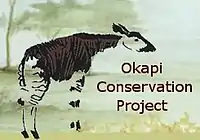Okapi Conservation Project
The Okapi Conservation Project (OCP) was founded in 1987 for the protection of the okapis (Okapia johnstoni) and their habitat. Okapis are found only in the Democratic Republic of Congo[1] and are seen as the major flagship species of the Ituri Forest.[2] The OCP has about one hundred staff members and one hundred and ten government rangers under the direction of the Institute in Congo for the Conservation of Nature. The Okapi Conservation Project is partnered with the Wildlife Conservation Network.[3] OCP's founder John Lukas is also a founding member of the Wildlife Conservation Network.[4] In 1992 the project helped create the Okapi Wildlife Reserve, encompassing 13,700 square kilometers of the Ituri Forest, which was designated as a United Nations World Heritage Site in 1996.[1][5]
 | |
| Founded | 1987 |
|---|---|
| Founder | John Lukas |
| Type | Non-profit Organization |
| Focus | Okapi Conservation |
| Location | |
Area served | Ituri Forest |
| Website | okapiconservation.org/ |
2012 attack
In June 2012 the headquarters for the Okapi Wildlife Reserve was taken over by poachers, intent on retaliating against the staff who had been stopping their elephant poaching and mining operations. Six guards and other staff as well as 14 okapis were killed in the incident. The local village was looted, women were raped and the conservation center was burned down.[6]
Programs
Okapi Wildlife Reserve
The Okapi Wildlife Reserve – an area 13,700 square kilometers, about one-fifth of the Ituri Forest – was created with the help of the Okapi Wildlife Project in 1992. The project continues to support the reserve by training and equipping wildlife guards and by providing assistance to improve the lives of neighboring communities.[1] The Okapi Wildlife Reserve was added to the list of World Heritage Sites in 1996, and since 1997 it has been listed as a World Heritage Site in danger.[7]
Agro-forestry
The program provides farmers with resources to make their farmland more productive, thus decreasing farmers' need for forest land.[1] The program also works to reforest unused areas.[8]
Conservation education and community assistance
OCP offers an education team that travels throughout the Okapi Wildlife Reserve, providing workshops, lectures, and presentations on the importance of biodiversity conservation and sustainable management of forest resources. The team also distributes education materials to all of the twenty-three schools in the Okapi Wildlife Reserve. They also assist in school construction.[1]
See also
References
- "Okapi Conservation Project". Wildlife Conservation Network.
- "Okapi Conservation Project". African Conservation Foundation.
- "Okapi Conservation Project". Wildlife Conservation Network.
- "WCN Board of Directors". Wildlife Conservation Network.
- UNESCO World Heritage Centre (1992–2017). "Okapi Wildlife Reserve". Retrieved 2017-10-27.
- "Tragic Losses in the Heart of Darkness". Huffington Post.
- "Poachers Attack Okapi Wildlife Reserve". Wall Street Journal Market Watch.
- "The Okapi Conservation Project". Houston Zoo.
External links
| Wikimedia Commons has media related to Okapia johnstoni. |
| Wikispecies has information related to Okapia johnstoni. |
- okapiconservation.org/ Okapi Conservation Project Website
- wildnet.org, Wildlife Conservation Network Website